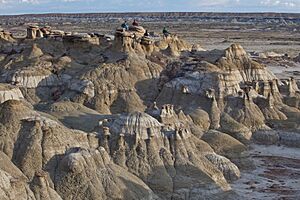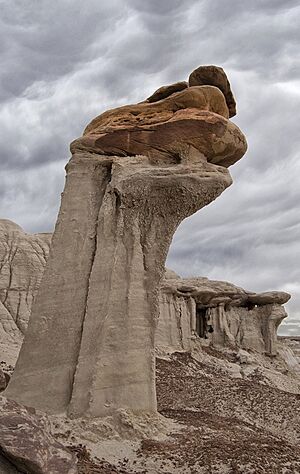Ah-Shi-Sle-Pah Wilderness facts for kids
The Ah-Shi-Sle-Pah Wilderness is a special protected area. You can find it in San Juan County, New Mexico. It's located between Chaco Canyon and the De-Na-Zin Wilderness. This wilderness is famous for its amazing landscapes.
It has colorful badlands, which are dry, eroded lands. You'll also see tall, strange rock formations called hoodoos. The area is also home to petrified wood and even dinosaur bones! It's a lot like the nearby Bisti Badlands.
Discovering Ah-Shi-Sle-Pah's Past
This unique area was first set aside for protection in May 1992. It was called a Wilderness Study Area (WSA) by the BLM. This protected about 6,563 acres, which is about 26.5 square kilometers.
A famous dinosaur hunter named Charles Hazelius Sternberg explored this area. He visited in the summer of 1921. Sternberg found the first known bones of a dinosaur called Pentaceratops fenestratus here. This dinosaur was a type of ceratopsid, a horned dinosaur. It lived during the late Cretaceous Period.
Many fossils from this area are now in Sweden. They are part of a large collection at the Museum of Evolution. This museum is at the University of Uppsala. It is against the law to collect fossils here without a special permit.
In 2019, a new law was passed. It's called the John D. Dingell, Jr. Conservation, Management, and Recreation Act. This law officially made Ah-Shi-Sle-Pah a part of the National Wilderness Preservation System. This means it is now protected even more. The protected area grew to about 7,242 acres.
The Rocks and Land of Ah-Shi-Sle-Pah
The rocks you see in the Ah-Shi-Sle-Pah Wilderness are very old. They are from the late Cretaceous Period. This was the time when dinosaurs roamed the Earth.
Most of the rocks are from the upper Fruitland Formation. This part is also known as the Fossil Forest Member. The lower part of the Kirtland Formation is also here. This section is called the Hunter Wash Member.
These rocks are mostly made of mudstones. You can also find layers of sandstone. Sometimes, there are stronger, harder sandstones from old river channels. These different rock layers create the amazing badlands and hoodoos you see today.



